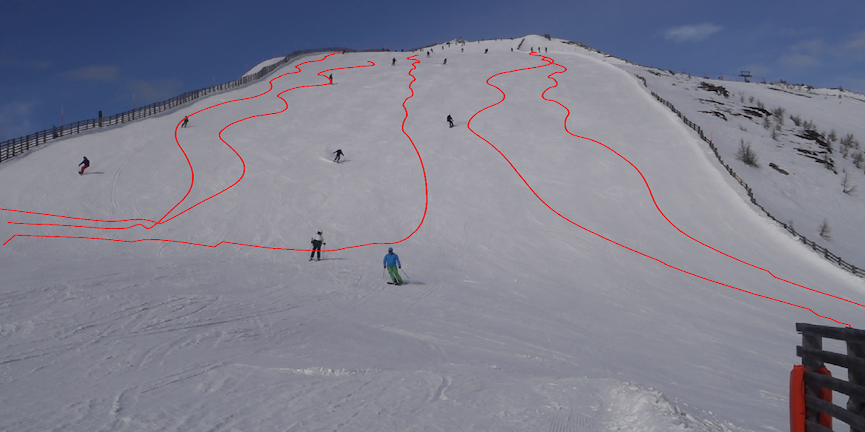Simulation of Downhill Skiing Areas
DOI:
https://doi.org/10.17815/CD.2024.166Keywords:
Self-driven particles, Model calibration, Cellular automata, Pedestrian trajectoriesAbstract
Based on video analysis of downhill skiing areas a model for ski traffic is developed. The video analysis uses PeTrack to determine the trajectories of individual skiers which are then statistically analysed. A stochastic cellular automaton model is proposed that can reproduce the basic observed features. The empirical data are used for validation and calibration of the model. In the future, the model may help to analyse comfort and safety on skiing slopes, especially the risk of collisions.
References
François, H., Samacoïts, R., Bird, D., Köberl, J., Prettenthaler, F., Morin, S.: Climate change exacerbates snow-water-energy challenges for european ski tourism. Nature Climate Change 13, 935 (2023)
Ruedl, G., Kopp, M., Butscher, M., Bauer, R., Benedetto, K.: Ursachen und einflussfaktoren von personenkollisionen auf der skipiste. Sportverletz. Sportschaden 27(2), 100 (2013)
Feliciani, C., Shimura, K., Nishinari, K.: Introduction to Crowd Management. Springer (2001)
Treiber, M., Germ, R., Kesting, A.: From drivers to athletes - modeling and simulating cross-country skiing marathons. In: Traffic and Granular Flow '13, p. 243 (2015). doi:10.1007/978-3-319-10629-8_29. URL http://arxiv.org/abs/1403.4965
Treiber, M., Hennecke, A., Helbing, D.: Congested traffic states in empirical observations and microscopic simulations. Phys. Rev. E 62, 1805 (2000). doi:10.1103/PhysRevE.62.1805
Holleczek, T., Tröster, G.: Particle-based model for skiing traffic. Phys. Rev. E 85, 056101 (2012). doi:10.1103/PhysRevE.85.056101
Korecki, T., Palka, D., Was, J.: Adaptation of social force model for simulation of downhill skiing. J. Comp. Sci. 16, 29 (2016). URL 10.1016/j.jocs.2016.02.006
Palka, D., Was, J.: Modeling skiers dynamics and behaviors. In: Lect. Notes Comp. Sci., vol. 10449, p. 97 (2017). doi:10.1007/978-3-319-67077-5_10
Burstedde, C., Klauck, K., Schadschneider, A., Zittartz, J.: Simulation of pedestrian dynamics using a 2-dimensional cellular automaton. Physica A 295, 507 (2001)
Boltes, M., Seyfried, A., Steffen, B., Schadschneider, A.: Automatic extraction of pedestrian trajectories from video recordings. In: Pedestrian and Evacuation Dynamics 2008, p. 43 (2010)
Kuratorium für Verkehrssicherheit: Injury database (idb) austria. Online (2022). URL http://www.kfv.at/. Data from 2013 to 2022
Wallner, B., Rugg, C., Paal, P., Ströhle, M.: Collisions with another person while skiing and snowboarding: A 13-year national registry analysis. Injury 53, 2485 (2022)

Downloads
Published
How to Cite
Issue
Section
Categories
License
Copyright (c) 2024 Buchuan Zhang, Tim Dressler, Alexander Maurer, Michael Nader, Andreas Schadschneider

This work is licensed under a Creative Commons Attribution 4.0 International License.
Authors contributing to Collective Dynamics agree to publish their articles under the Creative Commons Attribution 4.0 license.
This license allows:
Share — copy and redistribute the material in any medium or format
Adapt — remix, transform, and build upon the material
for any purpose, even commercially.
The licensor cannot revoke these freedoms as long as you follow the license terms.
Authors retain copyright of their work. They are permitted and encouraged to post items submitted to Collective Dynamics on personal or institutional websites and repositories, prior to and after publication (while providing the bibliographic details of that publication).








